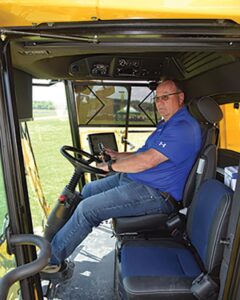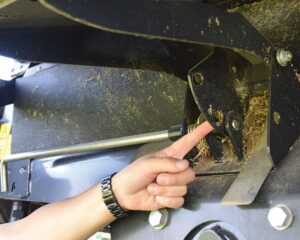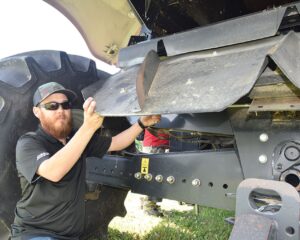13 tips from Combine College
1
Calibrate concave and sieve settings before harvest. For the sieves, set the monitor to what is the right starter setting for canola. Then go to the sieves and check. If the top and bottom sieves settings are 5/16˝, for example, use a 5/16˝ bolt or feeler gauge and make sure it slides snuggly between the grooves. If not, follow instructions in the user manual to calibrate. Do the same with the concave. Comments from instructors at Combine College suggest that differences can be significant, even for new machines.
2
Not all losses occur out the back of the combine. Header loss can occur if the reel hits canola pods and seeds fall to the ground, not on the header. Keep the reel as slow as possible. Specialty headers with knives that stick out in front of the reel can reduce these losses in canola. Crop dividers can also increase loss. A PAMI study on straight cut headers included a comparison of crop dividers. It concluded that vertical knife and fixed dividers had lower losses than the rotary knife divider. Other header considerations: Keep the knives sharp. Add an after-market shield (Crop Catcher from Michel’s) over the feederhouse to keep canola seeds in the combine. Losses can also occur in the middle of the combine. Murray Skayman, owner of MAD Concaves, says: “If you walk around the combine and see canola, it’s coming out somewhere.” Caulk or tape over holes.
3
Aim to have 90 per cent of canola threshed out at the concave. Skayman would run the rotor faster and the concave tighter to get that quick early threshing. As a concave specialist, he would also recommend removing a few bars to open up the front of the concave.
4
Keep top and bottom sieves open about the same distance for canola. Check the manual for recommendations. This will provide the airflow essential to lift the chaff and straw. This lifting separates the seeds. “Sieves are never the problem, unless they’re too tight,” Skayman says.
5
A clean sample might point to higher losses. “If the sample is really clean, I’m starting to worry,” Skayman says.
6
When using a drop pan, the ideal is to lift the spreader out of the way and drop straw and chaff. This concentrates the loss and gives a more accurate reading. However, operators will want to check again a couple of times after the spreader is re-engaged. The wind action of the spreader creates a vacuum that can suck material out of the combine faster, and could increase losses. Brendan Kamieniecki, agriculture equipment technician with Rocky Mountain Equipment, recommends a Case IH spreader speed of no more than 550 rpm with canola. Any higher and it starts to disrupt airflow. He also recommends punching out another hole on the spreader drop tray to lower it a notch. This gap reduces the vacuum effect at the back end.
7
Perform a kill stall. This will be in the manual and is a monitor setting on some combines. If not clear how to do it, check with combine dealer. A kill stall stops the combine dead to provide a snapshot of potential issues with settings. Open up the hatches and look for too much chaff on the sieves, too much load in the return elevator, full unthreaded pods, uneven loading
on the sieves.


8
Don’t assume anything. Sometimes automated systems on modern combines will make adjustments that are the exact opposite of what the operator would have expected. Combines have settings based on harvest strategies, such as “Limited loss” and “Maximum capacity”.
The goal with the limit loss setting, based on comments from the New Holland station, is to keep canola losses to under 0.5 bu./ac.
9
Get help from your combine dealership. For example, John Deere has an “Equipment Plus” app to provide baseline settings based on combine model, crop, estimated yield, and straw and seed moisture. It gives a start point for settings.
You may also see value in paying for help. Kamieniecki had one customer who had trouble getting losses below 1.5 bu./ac. for four combines, so the farmer paid Kamieniecki to adjust them.
He got losses down to 0.3 bu./ac., and billed $1,200. The yield gain was worth over $60,000, the farmer told him.

10
Standing canola needs different combine settings compared to swathed canola. Comments from the New Holland station described three settings to use as start points for standing canola: (1) speed up rotor rpms to handle greener plant material, (2) take wires out of the concave to release canola seeds faster, and (3) pull back the rotor vanes to keep crop inside the rotor for five rotations instead of three. Check with combine dealers for recommendations for specific models.
11
A lot of losses happen at headlands when the combine is empty yet the fan is still running at full speed. Kamieniecki recommends “Headland mode”, an option on some models, which slows the fan to keep small seeds like canola inside the combine.
12
High horsepower on modern combines is for tough conditions when you need that extra threshing capacity. Using horsepower to combine at eight miles per hour in good conditions can lead to heavy losses.
13
Read the manual and check out YouTube videos for tips on calibration of sieves and concaves, basics settings for each crop, kill stalls, and more. For example, a YouTube search for “Case IH 2188 sieve calibration” generated some good tips.
Read “Minimizing grain loss during harvest” in the Harvest Management section at canolaencyclopedia.ca


Try the CCC harvest calculators
Use the Harvest Loss Calculator and Combine Optimization Tool at canolacalculator.ca to improve canola harvest results. The Harvest Loss Calculator will calculate the amount of seeds in the drop pan into a bu./ac. and dollar per acre loss. If the spreader is disengaged, the discharge width is equal to the sieve width at the back of the combine. If the spreader is engaged, the discharge width is the cut width (swather or header). This is important to note when measuring loss when the spreader is disengaged and then engaged. (See point 6.) The Combine Optimization Tool walks through key settings based on the objectives: Grain Loss, Grain Sample Quality or Productivity.





